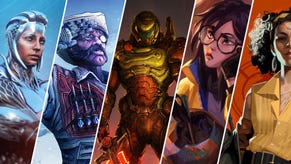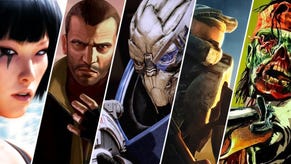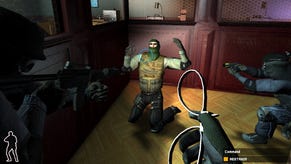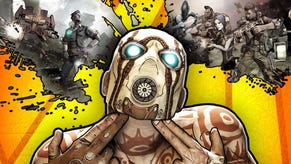Borderlands 2 interview: Randy P and the $500 game
Brenna Hillier is one of nature's soloists, but a co-operative session with Borderlands 2 has her swooning. Randy Pitchford talks us through the extreme value of one of the premiere multiplayer games of 2012.
"I want him to think, 'You know, I got more value out of Borderlands 2 than the previous like $500 I spent on other games.' And if he feels that? I win."
Gearbox staff have spoken in the past of Borderlands as a hobby, of players hitting the level cap but continuing to play with friends and collect rare weapons long past the end of the story. It's been compared to Diablo.
"We have telemetry of guys who have put 500, 600 hours into the game. That's awesome. I'm really proud of that," Gearbox boss Randy Pitchford told me.
Deservedly so. But the sequel is nearly upon us, and it's time to move on. Prior to letting us at a row of preview stations, Pitchford walked us through a gameplay demonstration, showing off each of the classes in turn. I registered an immediate moisty for Zero - both for my beloved sniping and the new, melee-focused ninja tricks - but in terms of co-op play I found more value in some tweaks to the other classes.
You could almost break it down by MMORPG classes. Maya, the Siren, has a healing bullets skill. Salvador, the Gunzerker, can taunt enemies, making him an effective tank. These abilities, along with other returning skills, have obvious tactical advantages for a co-operative team - but not much for solos. Does that mean I'll need to level two completely different versions of the same class, one for online play, and one for when I'm on my tod? Apparently not.
"I think you'll find in each tree there are skills that are really oriented towards a solo player, you'll find other skills that are really oriented towards a co-op player, and then you'll find most of the skills are versatile," Pitchford said, explaining that the Siren's Harmony tree offers versatile solo skills alongside healing bullets, meaning players can have both on one spec.
"I do think there are some trees more suited to collaborative play," the Gearbox boss acknowledged, and indeed it seems like some skills are going to be absolute musts for multiplayer fans. But unlike other multiplayer developers, Gearbox doesn't necessarily see this as a bad thing.
The developer built a telemetry framework - tested with a special build of Borderlands available to Steam users - which will allow it to harvest significant gameplay data from Borderlands 2. Presumably, this will show which skills are proving most popular, and tone them down a little bit to make play more varied, just as Blizzard's Diablo III team does.
"Maybe," Pitchford said. "The telemetry gives us information, but of course it doesn't make decisions.
"We do have a live team that we've committed to the game, so even though the game is done, there are people that are working on Borderlands 2 post-launch - to add value to the game and to maintain it and to improve it. One of the vectors of data that will inform that group will be telemetry, but it's not the only vector. The heart of the people on the team tends to be the loudest voice," he added.
"If something's broken or just way wrong, we'll consider that. I think philosophically we're less likely to nerf power and more likely to help underpowered [aspects]. It's kind of fun when you discover something that's game-breakingly awesome. We like that aspect of Borderlands, where there are edge cases with the procedural generation system.
"It's not just about balance, too; we might discover use cases that we didn't expect and that might inspire new ideas."
Meanwhile, the player isn't necessarily locked into their choices, should they discover a skill in an alternate tree which fires their heart and loins - although the scaling costs of respecs means higher-level players are in for a smack to the wallet.
"Respecs are not free. It's not a big price, it's just enough in balance to kind of make you feel that the spec you're building you have some commitment to, but not so much commitment to it that you can't make a new decision later if you want," Pitchford said.
"There's gonna be one kind of player who just has this one character, and another player who wants to try everything. Whether you're an exploratory kind of player who wants to try all the different permutations, or if you're more of a commitment player who wants to master and perfect one particular type of thing, we wanted to make sure there's stuff there for you to do."
There is plenty of stuff to do of course, and not just in the course of regular missions. Pitchford showed me an enormous boss called Terramopheus, a challenge for experienced, max-level co-op groups. I also checked out an arena-style mission in my hands-on session.
Although Pitchford was quick to correct me when I called the challenging waves of enemies a "horde mode", ("That kind of suggests that you launch this very specific thing from the menu," he said, whereas the arena we played was an optional mission encountered in the course of the story) the four of us zipping around the environment, combining abilities, reminded me very much of that kind of game. Even allowing for my inexperience, I found the arena tougher than I expected, and was surprised when the end of the first round after half a dozen waves didn't signal the end of the mission.
"There were a couple of arenas in Borderlands 1 but they were very simple and they were very quick. Although that kind of thing existed, it was very rudimentary and very simple; this is kind of the 2.0 of that idea," Pitchford explained.
Nevertheless, to my disappointment, it can't all be waves of robots. Don't imagine Borderlands has turned into Gears of Pandora.
"There's a couple of them in the game, but they're not that important to the overall," Pitchford added. He held out his hands several feet apart. "Like if this is Borderlands, that's like"; he made a tiny pinch.
"It's kind of what we did where - some people really liked the Mad Moxxi DLC. Some people did not. We kinda said, 'Let's just throw that into the game,' so it's there for free. It comes with Borderlands 2 instead of being a big DLC. And it's better now."
I really enjoyed my time with my high-level Zero, teleporting around the arena with insta-kill melees, but I was already wondering if I shouldn't have picked the sniper skill tree and backed off a bit from the action for a more strategic take, or taken the healing role. I felt a bit spoiled for choice and mentioned this to Pitchford, who chuckled and said one of Borderlands most appealing qualities is that it gives you options.
"It starts at the very beginning - which character do I play?" he said.
"What's neat about it is it also kind of says, 'There's a lot of value here; you own the game, so in due time explore it all'. Out time is limited, but - there's a lot of games out there. If I had a game that had very few options and I just kind of burned through it, than I'd be picking another game. But with Borderlands, because there's all these options, you can get three or four or five games' worth of value out of the one choice.
"Part of what drove a lot of us in Borderlands 2 is this idea that we want to entertain people, and we want goodwill from that, we want to gratify people. Part of gratification is that sense of value. Imagine a guy two months or two years after Borderlands 2 launches and he's thinking of all the fun he had - I want him to think, 'You know, I got more value out of Borderlands 2 than the previous like $500 I spent on other games.' And if he feels that? I win."
Borderlands 2 launches next month for PC, PlayStation 3 and Xbox 360.













